ASM Metals HandBook Vol. 8 - Mechanical Testing and Evaluation
Подождите немного. Документ загружается.

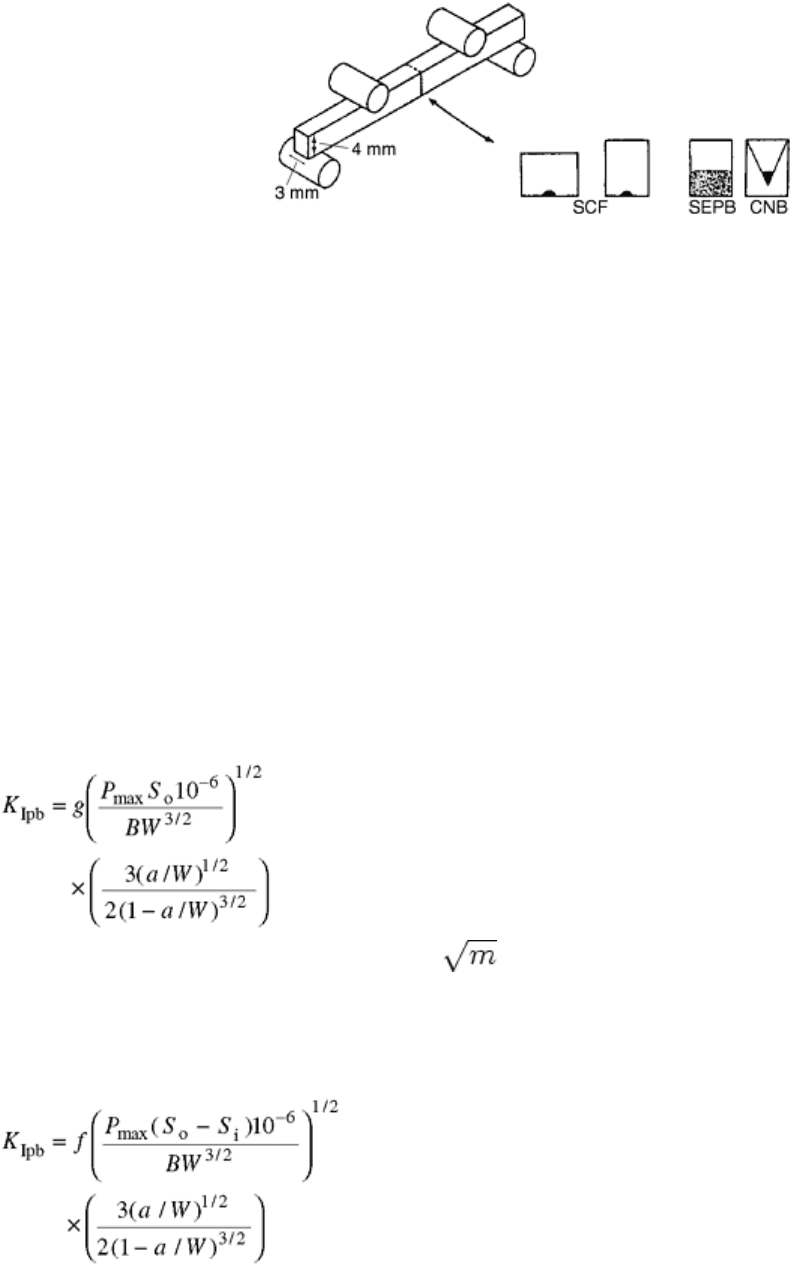
Fig. 5 Three test-method configurations for fracture-toughness testing of ceramics included in ASTM C
1421. SCF, surface crack in flexure; SEPB, single-edge precracked beam; CNB, chevron notched beam
In the case of the single-edge precracked beam (SEPB) test specimen, prior to fracture testing, a compression
bridge anvil is used with the 3 by 4 mm (0.12 × 0.16 in.) cross section “bend bar” test specimen to produce
precracks from either a saw notch or a series of Vickers indentations. The precracked test specimen is then
fracture tested in either three- or four-point flexure (20 by 40 mm, or 0.8 × 1.6 in., inner/outer spans in four-
point flexure is recommended, although outer spans as short as 16 mm, or 0.6 in., in three-point flexure are
permissible). Various methods are suggested for determining conditions of instability, stable crack extension,
and other anomalies that can affect the test results.
Requirements for the precrack include the following:
• Inclination of the precrack front must be a
av
- a
min
< 0.1 a
av
, where a
av
and a
min
are the average and
minimum precrack lengths, respectively.
• The inclination of the propagation direction on the bottom surface and both sides of the specimen is ≤5°.
• The precrack length is between 0.35W and 0.60W, where W is the test specimen height.
For three-point flexure, the fracture toughness by the SEPB method is calculated as:
(Eq 10)
where K
Ipb
is the fracture toughness (in MPa ) using the SEPB method, P
max
is the maximum force (in
newtons) at fracture, S
o
is the outer support span (in meters), B is the test specimen breadth (in meters), W is the
test specimen height (in meters), a is the precrack length (in meters), and g is the geometry correction factor
that depends on the three-point flexure geometry (Ref 17, 18).
For four-point flexure, the fracture toughness by the SEPB method is calculated as:
(Eq 11)
where S
i
is the inner support span (in meters) and f is the geometry correction factor that depends on the four-
point flexure geometry (Ref 17, 18).
In the case of the surface crack in flexure (SCF) test specimen, a Knoop indenter is used to create a
semielliptical surface precrack. An essential step in this method is the removal of residual stresses induced by
the indenter. Grinding and polishing are recommended whereas annealing is not because it can lead to crack
healing and crack tip blunting. The precracked test specimen is then fracture tested only in four-point flexure
(20 and 40 mm, or 0.8 and 1.6 in., inner and outer spans, respectively). Post-test fractography is necessary to
determine the precrack size for the calculation of the fracture toughness. It has been argued that the SCF
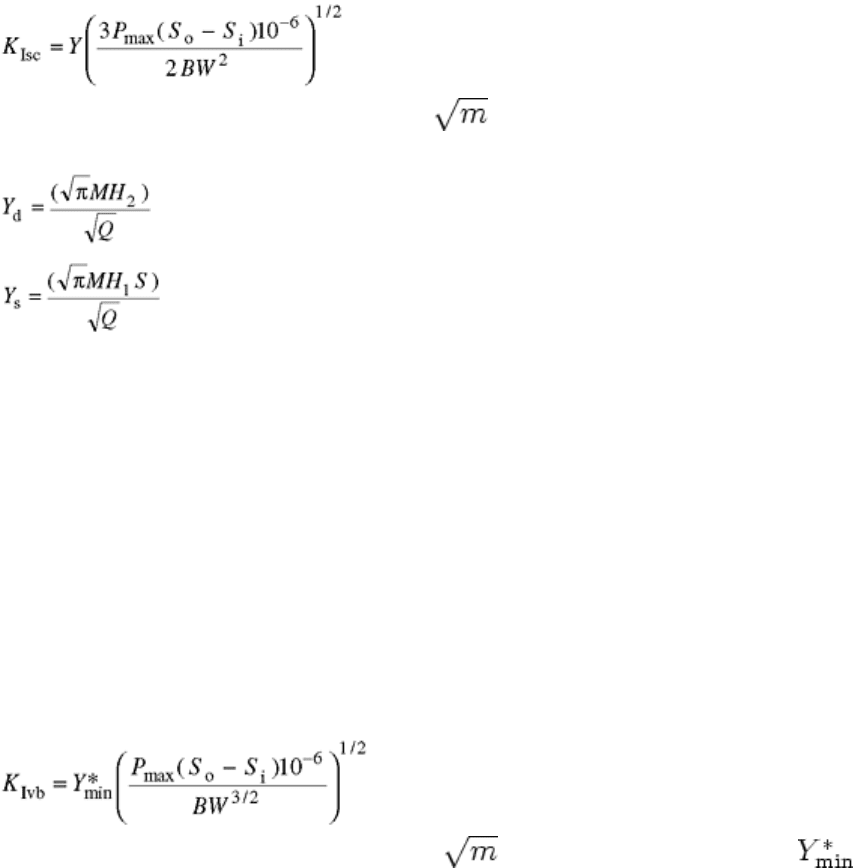
method may give results representative of the intrinsic fracture resistance of the material because the induced
flaw can be on the order of the intrinsic flaws (Ref 9).
The fracture toughness by the SCF method is calculated as:
(Eq 12)
where K
Isc
is the fracture toughness (in MPa ) using the SCF method and Y is the greater of two possible
geometry correction factors:
(Eq 13a)
(Eq 13b)
where M, H
1
, H
2
, Q, and S are dimensionless functions based on an assumed half semiellipsed precrack shape
(Ref 17, 18).
In the chevron notched beam (CNB) test specimen, a V-shaped notch is cut in the “bend bar” with the tip of the
V oriented to the tensile stress during fracture testing. The advantage of the CNB test is that no prior
precracking is required. Instead, the crack initiates at the tip of the chevron during testing. The crack then
propagates through the chevron in a stable manner because the chevron presents an ever-widening crack front
to the propagating crack. Examination of the loading curves provides an indication of stable fracture (e.g.,
smooth, nonlinear rollover), a necessary requirement for a valid CNB test. Either three- or four-point flexure is
allowed for the CNB with allowable test geometry parameters (L, W, S
o
, and S
i
) dependent on the test
configuration chosen (A, B, C, or D) (Ref 18). Valid tests must have chevron notch planes that meet within
three notch thicknesses; the tip of the chevron must be less than 2% of the test specimen breadth, B, from the
centerline; and the difference between the two chevron length measurements and the average of the chevron
length must be less than 2% of the test specimen height, W.
The fracture toughness by the CNB method is calculated as:
(Eq 14)
where K
Ivb
is the fracture toughness (in MPa ) using the CNB method and is the minimum stress
intensity factor coefficient for the relevant geometry (Ref 17, 18).
Interferences addressed in ASTM C 1421 include slow crack growth (i.e., environmentally assisted crack
growth), R-curve effects, and stability. Other methods considered but not addressed in the standard include
indentation strength in bending (ISB), indentation fracture (IF), double cantilever beam (DCB), and single-edge
notched beam (SENB). Discussions of why these methods were not included in the ASTM standard are
provided elsewhere (Ref 9).
JIS Standard for Fracture Toughness of Ceramics. In 1990, the Japanese Industrial Standards Committee (JISC)
adopted the Japanese Industrial Standard (JIS) R1607 “Testing Methods for the Fracture Toughness of High
Performance Ceramics” (Ref 19). This standard contains two test methods for the determination of the fracture
toughness of ceramics: SEPB and IF.
Similar to the ASTM SEPB method, either Vickers indentations or a straight notch can be used as “starters” in
the 3 by 4 mm (0.12 × 0.16 in.) cross section bar prior to the use of the compression bridge anvil. Unlike the
ASTM SEPB method, after introducing the precrack, the fracture test is conducted only in three-point flexure
using either 16 or 30 mm (0.63 or 1.18 in.) outer spans. Requirements for the precrack include the following:
• The length variation and inclination of the precrack front must be (a
max
- a
min
)/2 < 0.1, where a
max
and
a
min
are the maximum and minimum precrack lengths, respectively.
• The inclination of the propagation direction on the bottom surface and both sides of the specimen is
≤10°.
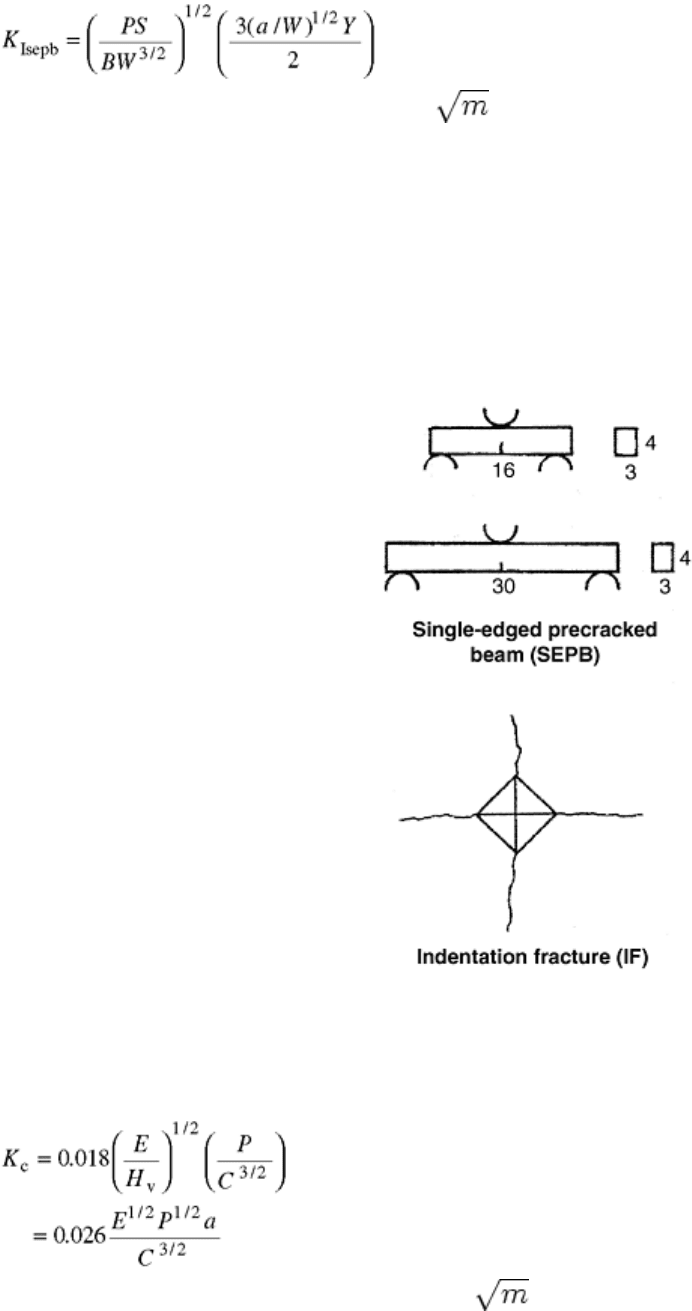
• The precrack length is between 1.2 and 2.4 mm (0.05 and 0.09 in.).
The fracture toughness by the SEPB method is calculated as:
(Eq 15)
where K
Isepb
is the fracture toughness (in MPa ) using the SEPB method (Ref 19). The average of five valid
tests is reported.
For the IF method, a Vickers hardness tester “at a large load” is used to create the impression (cracked from
corners), as shown in Fig. 6. Within 10 minutes after the creation of the indentation, both diagonal dimensions
(two corner crack lengths combined with the indentation diagonal length) are measured. The corner cracks must
satisfy the following conditions:
• Cracks start at the corner of the indentation and propagate in the diagonal direction.
• Lengths of any two cracks normal to each other differ by less than 10% of the average crack length.
• Any crack length is at least 2.5 times the diagonal length of the indentation.
Fig. 6 Two methods for fracture-toughness testing of ceramics contained in JIS R1607-90. Dimensions in
millimeters. Source: Ref 19
The quasi-fracture toughness is calculated as:
(Eq 16)
where K
c
is the quasi fracture toughness (in Pa ) using the IF method, H
ν
is the Vickers hardness (in
pascals), C is half the average crack length (in meters), and a is half the average diagonal length of the
indentation (in meters). There is considerable controversy surrounding the result of the IF for accurate and
precise measurements of fracture toughness. Two obvious concerns are the choice of the “calibration constant,”
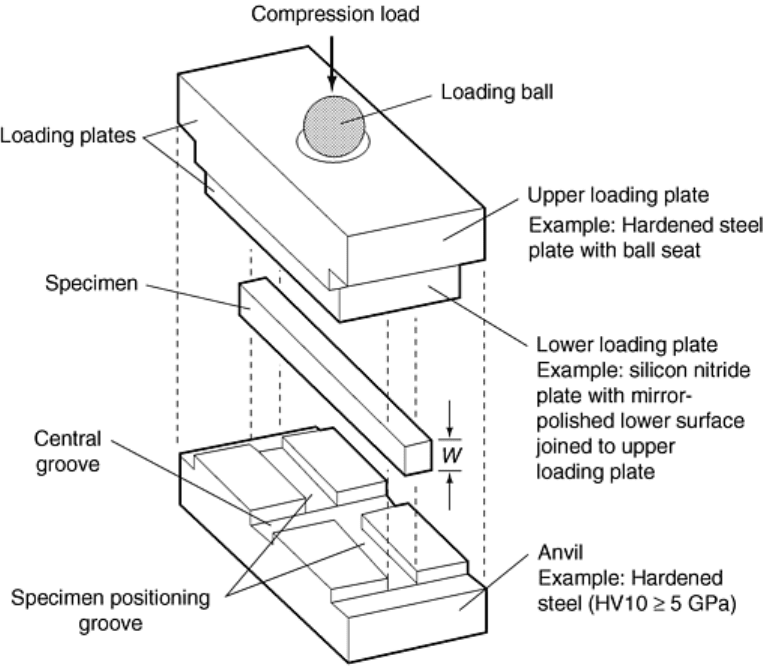
which is 0.018 in Eq 18 but could be one of over 19 different values (Ref 20, 21) and the highly subjective
estimate of the final crack tip. Even JIS R1607 states that the result of the IF method cannot be strictly
considered a fracture toughness.
ISO Standard for Fracture Toughness of Ceramics. The International Organization for Standardization (ISO)
made significant progress in 1999 when ISO DIS15732, “Fine Ceramics (Advanced Ceramics, Advanced
Technical Ceramics)—Test Method for Fracture Toughness of Monolithic Ceramics at Room Temperature by
Single Edge Pre-Cracked Beam (SEPB) Method” (Ref 22) was approved. In addition, a new working group has
introduced an advanced draft of an SCF fracture testing method (Ref 23). ISO Technical Committee (TC) 206
has oversight of both these efforts, although in this article only ISO DIS15732 is discussed in detail because
many of the essential aspects of the current draft of the SCF test method are similar to the SCF test method
contained within ASTM C 1421. “Harmonization” of existing national and regional standards, not development
of completely new standards, is one of the charter goals of ISO TC206.
ISO DIS15732 is a combination of the two existing national standards containing the SEPB fracture test
method: ASTM C 1421 and JIS R1607. Because the proper introduction of the precrack is critical to the success
of the SEPB method for both ASTM and JIS standards, explicit directions and illustrations are provided in an
annex (Fig. 7). Both three- and four-point flexure are allowed in certain outer and inner support spans, again, as
contained in both the ASTM and JIS standards (Fig. 8). Also, as contained in the ASTM and JIS standards,
either a row of Vickers (or Knoop) indentations or a saw notch are allowed for the precrack starter. Similarly,
the cross section of the beam is 3 by 4 mm (0.12 × 0.16 in.) with minimum lengths ranging from 18 to 45 mm
(0.7–1.8 in.) depending on the testing configuration.
Fig. 7 Illustration of compression bridge anvil for fracture-toughness testing of ceramics in ISO DIS
15732. Source: Ref 22

Fig. 8 Test configurations for ISO DIS 15732. For three-point bend (flexure), S1 can be 16 or 30 mm
(0.63 or 1.18 in.). For four-point bend (flexure), S1 can be 30 mm (1.18 in.) with S2 at 10 mm (0.39 in.), or
S1 can be 40 mm (1.57 in.) with S2 at 20 mm (0.79 in.). Source: Ref 22
Notable additions to ISO DIS15732 not contained in either the ASTM or the JIS standards are sections on
determining precrack length and stable crack growth using compliance changes and fractography. Additional
sections deal with permissible range of stable crack growth (≤2% of the average precrack length) and
permissible relative compliance change (≤10% of the ratio of precrack length to test specimen height).
Requirements for the precrack include the following:
• Length variation and inclination of the precrack front must be (similar to JIS R1607) (a
max
- a
min
)/2 <
0.1, where a
max
and a
min
are the maximum and minimum precrack lengths, respectively.
• The inclination of the propagation direction on the bottom surface and both sides of the specimen is ≤5°
for the three-point flexure geometries and ≤10° for the four-point flexure geometries (mixture of JIS
R1607 and ASTM C1421).
• The precrack length is between 0.35W and 0.60W, where W is the test specimen height (similar to
ASTM C1421).
Notes are provided regarding R-curve effects (the measured fracture toughness may be “artificially high” if
stable crack growth occurs after pop-in of the precrack) and slow crack growth effects (the measured fracture
toughness may be reduced because of environmentally assisted crack propagation).
The fracture toughness by the SEPB method is calculated using Eq 15 for the three-point flexure geometries
and Eq 11 for the four-point flexure geometries. Five or more valid test results are used in calculating an
average fracture toughness value.
CEN Standard for Fracture Toughness of Ceramics. Comité Européen de Normalisation (CEN) is the de facto
standards-writing body for the European Union. As of 1999, a pre-Euro Norm Voluntaire (preENV) had been
drafted indicating the intent to develop a seven-part fracture-toughness testing standard within CEN Technical
Committee (TC) 184 on Advanced Technical Ceramics. The first part of this standard is currently in draft form
and provides summaries of the six test methods contained in each of the following six sections, as well as
guidance to the user as to choice and application of a particular test method (Ref 24).
A pictorial summary of the six test methods is shown in Fig. 9; a summary and comparison are provided in
Tables 1 and 2, respectively. Note that with the exception of the IF method, all six methods use “bend-bar” test
specimen geometries. Of the six, the SEPB method is contained in the current ASTM, JIS, and ISO standards.
The CNB method is contained in the ASTM standard, as is the SCF method. The IF method is contained in the
JIS standard. Two methods not yet standardized are the single-edge V-notch beam (SEVNB) and the
indentation strength (IS) methods. These two methods are discussed briefly here.

Table 1 Methods for determining apparent fracture toughness using small test specimens
Method Description Calibrations
Uncertainties or difficulties
Single-edge
precracked
beam (SEPB)
A flexural test in a
beam into the tensile
side of which a short
straight crack has
been introduced
Accurate calibrations
available for wide range of
precrack lengths. Fracture
toughness is determined at a
defined crack length.
Precracking requires some skill to
obtain straight-fronted cracks.
Results are influenced by rising
fracture-resistance behavior.
Chevron
notched beam
(CNB)
A flexural test in a
beam into the tensile
side of which a short
straight crack has
been introduced
Accurate calibrations
Fracture toughness is calculated at
assumed crack length. Crack
initiation may be difficult in some
materials due to machining residual
stresses. Result may be influenced
by rising fracture resistance
behavior.
Surface crack
in flexure
(SCF)
A flexural test in a
beam into the tensile
side of which a short
straight crack has
been introduced
Accurate calibrations
assuming the precrack shape
approximates to an ellipse
after removal of surface
damage region
Requires observation and
measurements of precrack
dimensions, which may not be
clearly visible. Limited to materials
in which indentation produces
good-quality cracks. Result typical
for small cracks
Single-edge V-
notch beam
(SEVNB)
A flexural test in a
beam into the tensile
side of which a short
straight crack has
been introduced
Accurate calibrations
assuming sharp crack (same
as SEPB)
Assumes that if the tip radius of the
sharp notch is of the order of the
grain size, then the notch is
equivalent to a sharp crack and the
SEPB calibration can be used
Indentation
fracture (IF)
A flexural test in a
beam into the tensile
side of which a short
straight crack has
been introduced
Poor calibrations owing to
uncertainties in stress fields
developed by indentation
methods of cracking. Wide
variety of different
calibrations available
Effective only in materials that do
not chip or flake when indented.
Inappropriate for tough or porous
materials. Result typical for small
cracks
Indentation
strength (IS)
A flexural test on a
beam into the
tensile side of which
has been placed an
indentation
Poor calibrations owing to
uncertainties in residual
stress fields developed by
indentations that are not
removed
Reproducible test if well-defined
cracks are developed by
indentation. Result typical for small
cracks, but may not be indentation-
force dependent. Inappropriate for
porous materials
Adapted from Ref 24
Table 2 Comparison of fracture-toughness test methods
Test method
Criterion
SEPB CNB SCF SEVNB
(a)
IF
IS
Confidence in
calibration
(b)
Good Good Good Good Poor
Poor
Relative ranking of
materials
Yes Yes Yes Yes Possible for
similar
materials
Yes
Long-crack fracture
toughness
Yes Yes No No No
No
Determine R-curve Yes No No No
(c)
No
No
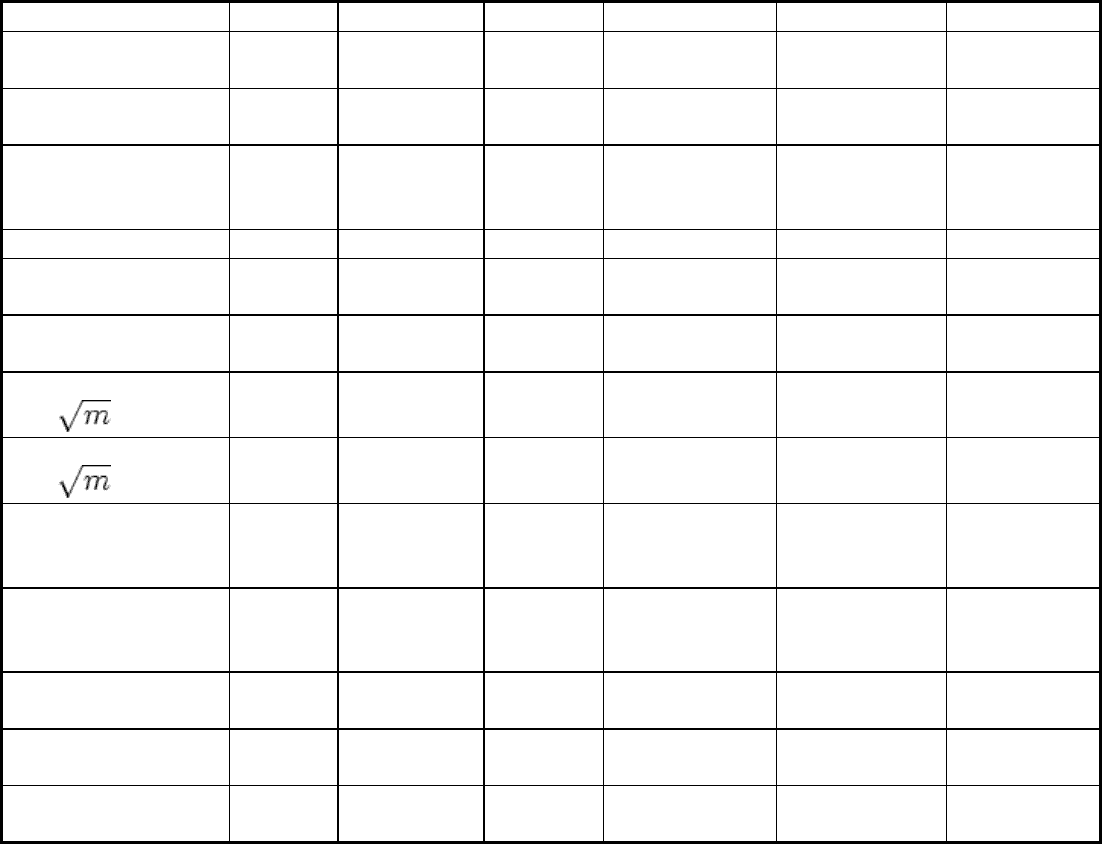
effects
Short-crack fracture
toughness
No No Yes Yes
(d)
Yes
Yes
Fast-fracture fracture
toughness
Yes No Yes Yes Yes
Yes
Controlled-crack-
growth fracture
toughness
Possible Yes No No No
No
Low scatter results Possible Possible Yes Yes No
Yes
Fine-grained
materials
Yes Yes Yes Yes Yes
Yes
Coarse-grained
materials
Yes Yes Unlikely Yes Unlikely
Unlikely
OK if K
Ic
< 6
MPa
Yes Yes Yes Yes Yes
Yes
OK if K
Ic
> 6
MPa
Yes Yes Possible
(e)
Yes No
No
Sensitive to crack
growth before
fracture
Yes Uses a
moving
crack front
Yes Possible Yes
Yes
Sensitive to
notch/precrack
geometry
Possible Probable Yes Possible for
fine-grained
materials
Not
appropriate
Not
appropriate
Suitable for elevated
temperature
Yes
(f)
Yes Yes
(f)
Yes No
Possible
(f)
Cost of effort to do
tests
High Medium High Medium Low
Medium
Cost of facilities to
do tests
Medium
Medium High Medium Low Medium
(a) Attributes given are for notch root radii of ≤5 μm.
(b) On a fracture mechanics basis alone, the quality of the experimental result is influenced by the nature of the
material.
(c) Unless used initially to grow a crack from a notch.
(d) If the notch is considered to have a short flaw at its tip, R-curve effects are avoided.
(e) Increasing likelihood of poor precrack generation with increasing fracture toughness.
(f) Upper temperature limit is crack-tip blunting, crack healing, and/or oxidation. Adapted from Ref 24
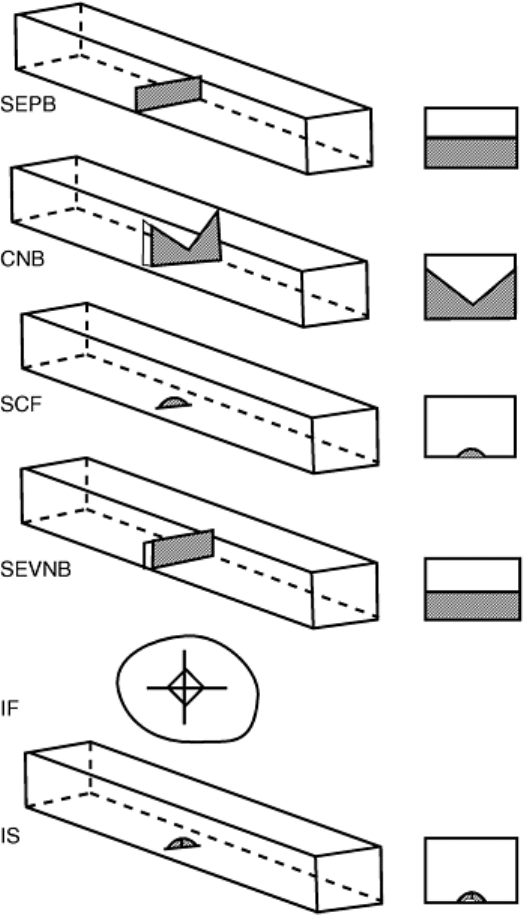
Fig. 9 Pictorial summary of test methods contained in CEN TC184 draft fracture toughness standard
(Ref 24). SEPB, single-edge precracked beam; CNB, chevron notched beam; SCF, surface crack in
flexure; SEVNB, single-edge V-notched beam; If, indentation fracture; IS, indentation strength
The SEVNB method is a variation of the single-edge notch beam (SENB) method, which has been a mainstay
of the fracture testing community since before the introduction ASTM E 399. However, in brittle materials, the
SEVNB addresses a problem that had long plagued the SENB method: how should a sharp crack at the tip or
root of the saw notch be introduced? No matter how thin the diamond saw blade (even 50–100 μm thick), a
blunt notch is still not an atomistically sharp crack, and, hence, without the introduction of a precrack at the
notch tip (e.g., fatigue precracking or SEPB compression bridge loading), the SENB test does not meet one of
the basic requirements for a fracture toughness test: a well-defined, atomistically sharp crack. When compared
to sharp-crack methods, blunt-notch methods tend to “overestimate” fracture toughness with results that are
often a function of notch thickness (e.g., see Ref 25 for a comparison of results for sharp-crack and blunt-notch
techniques for alpha silicon carbide).
What sets the SEVNB method apart from the usual SENB method is that after the initial notch is sawed into the
beam, the notch tip is “sharpened” (Ref 26, 27). In the latest rendition of the SEVNB method, a reciprocating
(either manual or mechanized) conventional razor blade is used, along with various grits of diamond paste, to
create the V at the tip of the saw notch (Ref 27). This V-notching technique tends to create notch root radii (or
damage zone) less than those that would make the measured fracture toughness a function of the notch width or
geometry. The SEVNB method produces precise and accurate results similar to sharp-crack methods (e.g.,

SEPB and SCF) without the need to precrack the test specimen (Ref 27). In addition, measurement of the notch
depth at fracture allows the use of the same well-established equations, such as those used for SEPB method
(e.g., Eq 11, 12, and 15) for calculating fracture toughness.
The IS method is based on the applications of Eq 1 and 4 to the flexural strength testing of flexural test
specimens that have been indented (either Knoop or Vickers) with ever-increasing indentation forces. The size
of the controlled indentation flaw increases with increasing indentation force. Therefore, for a material with a
deterministic fracture resistance, the measured flexural strength will decrease with increasing flaw size (or
increasing indentation force). The mathematics have been worked out relating fracture resistance, flexural
strength, and flaw size for sharp indenters producing median cracks (Ref 3).
The actual mechanics of the conducting test involve first placing one indentation each in a series of standard
flexure test specimens (each test specimen receives one indentation at one indentation force), such as those
specified in ASTM C 1161 (Ref 28) at ever-increasing indentation forces using either a Knoop or Vickers
indenter. A standard flexural strength test is then conducted, preferably in four-point flexure to avoid the
necessity of trying to align the small indentation with the nose of the loading support in three-point flexure. For
four-point flexure, the flexural strength is calculated as:
(Eq 17)
where S
f
is the flexural strength and P
f
is the force at fracture (typically maximum force for a brittle material).
The fracture toughness using the indentation strength method for the particular test can then be calculated using
the relation (Ref 29):
(Eq 18)
where P is the indentation force.
Obvious advantages of the IS method are that it involves readily available flexure test specimens and test
standards for both flexure strength and indentations. In addition, the IS method does not require a subjective
measure of crack size (from the viewpoint of the fracture-mechanics community, this is also an obvious
weakness) (Ref 2). Another weakness is that hardness and elastic modulus need to be measured separately. A
final point is that the constant 0.59 in Eq 18 as determined from logarithmic regression analysis (Ref 2) has an
estimated standard deviation of 0.12 (a somewhat large source of variability for a “constant”). While the IS
method is attractively simple, relative measurements on a given material “are typically reliable to much better
than 20%” (Ref 3), making the results of limited value compared to some of the other methods discussed up to
this point.
Other Test Methods for Fracture Toughness at Ambient Temperature
Many other successful methods for determining fracture toughness of brittle materials (not yet standardized)
have been introduced and refined over the past several years. Some of the more popular methods are discussed
in the following sections. Note that these discussions are limited to sharp-crack methods because of the
limitation of methods using blunt notches.
The double torsion (DT) method was once seen as a strong contender for a standard test method (Ref 4, 7, 8, 9,
and 10). This method (Fig. 10) allows the use of a variety of basic specimen shapes and test geometries,
although the most common is a long, thin plate with a side groove cut along its length to guide and crack
(although there is evidence that with good alignment, better results are obtained without the groove (Ref 31).
Ball-bearing supports tend to minimize friction and help alignment. Various analyses have shown that the
applied stress intensity factor is independent of crack length over the dimensionless crack length range of 0.55
to 0.65 a/W (Ref 4). One formulation for stress intensity factor for determining fracture toughness using the DT
method is (Ref 30):
(Eq 19)
where W
m
is half the test specimen width minus half the notch width, d is the total thickness, d
n
is the notch
depth, and ξ is a correction factor for thick test specimens such that ξ = 1 - 0.6302t + 1.20t exp (-π/τ) where t =

2d/W and W is the total width of the test specimen. Although the three-dimensionality of the crack front in the
DT test specimen has lead to some controversy about whether Eq 19 really represents a mode I stress intensity
factor, evidence exists that K
Idt
for various brittle materials compares well to other sharp-crack mode I methods
(Ref 25, 30). Obvious advantages of the DT method include the simple loading configuration, its constant stress
intensity factor geometry, simple test specimen geometry, and stable crack propagation configuration. Some
disadvantages include the relatively large volume of test material (compared to a simple flexure bar) required
for a single test, the more complicated arrangement of ball bearings and other components for supports, the
curved crack front, and concerns about the three-dimensionality of the crack tip.
Fig. 10 Schematic illustration and nomenclature for double torsion (DT) fracture-toughness test
methods. Source: Ref 30
The double cantilever beam (DCB) test method has been part of fracture mechanics in various forms since the
inception of the discipline. Indeed, variations of the DCB method even appear in ASTM E 399 for fracture
toughness testing of metals. A unique aspect of the DCB test method applied to brittle materials is the method
of load application that can have a variety of forms, as shown in Fig. 11. The applied-load method can be
particularly troublesome in brittle materials that are susceptible to tensile forces. However, the compressively
loaded wedge-loading method and the compressively loaded applied-moment method are suited to testing
brittle materials. Often side grooves are used to guide the crack longitudinally. For the applied-load geometry,
the stress intensity factor and subsequent fracture toughness have been formulated as (Ref 4):
(Eq 20)
where h is half height of the test specimen, b is thickness of the test specimen, and a is the crack length. Some
advantages of this geometry are that for some cases the stress intensity factor is independent of crack length
(e.g., tapered DCB or applied moment DCB), test specimen preparation can be simple, material usage is
efficient, and the loading configuration can be simple. The primary disadvantage is that a sharp crack needs to
be introduced to avoid problems of initiation and propagation of a crack from the blunt notch.
